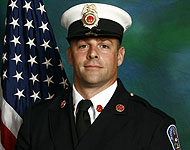
By David Howell
Identifying an issue or deficiency means making a change to what we are currently doing or not doing. No idea no, matter how good it is, can work if firefighters lack the discipline to follow their new orders. The process of implementing change also involves developing the people who are meant to follow these changes. If you get your firefighters to buy in to change and take ownership, the rest is easy.
As the saying goes, you are only as strong as your weakest link. Policies are only as good as the people who are meant to follow them. Those individuals who have self-discipline follow directions no matter who is watching or not watching; they immediately take pride and ownership in changes. Most individuals lack self-discipline, however, so it must be developed in them. Developing employees along with our policies and procedure can achieve the homeostasis required to run a good organization. Following the Pride and Ownership Development Chain (PODC) will lead to the pride an ownership that is necessary to create balance between administration and the operations.
Uniformity coupled with enforcement will then change the culture within an organization. Employees will then begin to buy in to the organization as they are rewarded for the change. Consistency then solidifies the buy in to traditions. Over time, employees will develop pride and ownership in the organization. Once employees reach this level, they will begin to police themselves and the choice between doing what is right and what is easy will be no more.
Choosing the PODC model as the philosophy of your department will have a multifaceted effect: morale will increase, the job will become easier, and efficiency will increase. When people believe in what they do and take pride in what they accomplish, they are genuinely happier workers. Also, when they know what is expected of them and know it won’t continually change, they find it easier to be productive. Productive employees lead to better outcomes and better services.
Uniformity is the root of all that is necessary to achieve discipline throughout a department. Clear, concise, and well-thought-out policies and guidelines are essential. There must be a document for everything we do, such as house curricula, standard operating procedures (SOPs) and guidelines, and codes of conduct.
- SOPs are created to provide specific documentation for various processes, usually highly technical processes. SOPs are developed when there are inadequate processes or definitions regarding a task or situation, or if there is no documentation at all in place.
- A code of conduct is a set of conventional principles and expectations that are considered binding on any person who is a member of a particular group
- House curricula consist of textbooks written by an organization to outline the specific ways they conduct business, perform skills, use equipment, and apply knowledge. They are based on current standards and practices form other larger curriculums and textbooks.
Once you establish your rules, they must be enforced. Any crack in the enforcement system allows dissent and interpretation. The organization must stand strong and firm. Most importantly, the connection between the field and the administration must be strong. Any and all questions or concerns should be answered promptly.
As resistance begins to wear down, cultural change will begin to take place. What used to be resisted becomes tolerated. At this critical point, the employee must see some benefit or reward for their change or they will begin to tear it down as useless management redirection or misdirection. Rewards can come in as simple a form as a “thank you” or “great job.” Reward can come in more complex forms, like lessening workloads or giving more freedom to operate, or even materialistic forms like buying better supplies or equipment.
Once people see the reward of maintaining self-discipline and doing the right thing, they will begin to buy in to the system, meaning they now see it as the only way to act and operate. They feel that they are a part of a team that works together. When they make disciplined choices, even if it means doing something they don’t like, everyone wins in the end.
This brings us to the critical factor of consistency, without which all the hard work done up to this point will be for nothing. Any organization can force employees to do what they are told. This will last only until they see that no matter what they do it will just change tomorrow or if they don’t like it they can go somewhere within the organization where I won’t be held accountable. However, if you stay consistent, traditions will be formed. Then what was new and maybe disliked becomes “just what we do.”
When you have tradition, employees feel strong and connected. They develop pride in what they are doing and feel ownership in the materials they use and maintain. Then when an undisciplined employee acts out or goes against tradition, they will be policed not by the supervisor but by their peers, who take it personally when someone goes against what they believe in. The employees who are vested in the company, having spent years of service in maintaining self-discipline, become unflappable.
When you are implementing change, follow the same process each time. The PODC Model is an example of how you create change, cultivate it, and then solidify it. Don’t stop cultivating change until it solidifies itself at the level of tradition, then let pride and ownership reign stronger than any supervisor ever could.
 David Howell is a captain with Horry County Fire Rescue in South Carolina. He has 11 years of service.
David Howell is a captain with Horry County Fire Rescue in South Carolina. He has 11 years of service.

